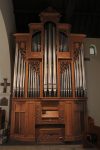A Unique Sacrifice
On the 11th hour of the 11th day of the 11th month, hostilities ceased – exactly 100 years ago today. On November 11, 1918, German leaders met with Allied leaders in a railroad car in France, and there they signed an armistice agreement — a suspension of hostilities. The war to end all wars was over, and no more blood would be shed.
Then the remembrances began. One year later, November 11 was declared in many countries to be Armistice Day, which is what my mother always called it. It became a federal holiday in the United States in 1938, and later, in 1954, the name was changed to Veterans Day. It is now a holiday dedicated to all Americans who served in the armed forces.
In countries of the British Commonwealth, it’s called Remembrance Day, or Poppy Day. These flowers are symbols of World War I, tied to the poppies that began to grow after the burial of fallen soldiers in the Flanders Field cemetery in Belgium. The poem “In Flanders Fields” by John McCrae includes the lines:
In Flanders fields the poppies blow / between the crosses, row on row …
We are the Dead. Short days ago / we lived, felt dawn, saw sunset glow,
Loved and were loved, and now we lie, / in Flanders fields.
We have been observing this day for 100 years. The red poppies of Flanders Fields symbolize the blood that has been sacrificially shed. If you watch hockey, you may have noticed that all those Canadian NHL coaches have been wearing red poppies in the lapels of their suit coats. It helps us remember the significance of sacrifice.
Today’s Epistle from the Letter to the Hebrews speaks of Jesus as the One who came to “remove sin by the sacrifice of himself” (v. 26). He shed his own blood on the cross, once for all. Jesus was not like the high priest in the Jerusalem temple who entered “the Holy Place year after year with blood that is not his own” — that is, with the blood of a sacrificial animal (v. 25). No, Jesus offered his own blood on the cross, and his sacrifice was offered one time “to bear the sins of many” (v. 28).
The red poppies are associated with veterans. The color red reminds us of the blood of Christ on the cross. But what is the true significance of sacrifice offered by veterans and by Jesus?
When veterans make their sacrifice, they give up their own security for the security of others. They put themselves in harm’s way to protect their family members, friends and neighbors from danger.
But not every veteran is a fighter. Desmond Doss was a devout Christian who refused to touch a weapon or work on the Sabbath. He enlisted in the Army during World War II because he believed in the cause, offering to be a combat medic.
At first, the Army wanted nothing to do with him. He just didn’t fit into the Army’s model of what a good soldier should be. Members of his battalion considered him a pest. They saw him as a slacker and threw shoes at him while he prayed.
But at Okinawa in the spring of 1945, Doss and his company faced a grueling task: They had to climb a steep, jagged cliff and face thousands of heavily armed Japanese soldiers. Under heavy fire, Doss climbed the ridge and crawled from wounded soldier to wounded soldier, dragging them to safety. He was praying the whole time, “Lord, please help me get one more.”
In the end, Doss saved 75 men over a 12-hour period. The soldiers who had shamed him now praised him, and his captain described him as “one of the bravest persons alive.” President Harry Truman awarded Doss the Medal of Honor in 1945, and more than 70 years later, he was the hero of the movie Hacksaw Ridge. He was an example of a veteran who gave up his own security for the security of others, both on the battlefield and back at home.
When Jesus made his sacrifice, he “appeared once for all at the end of the age to remove sin by the sacrifice of himself” (v. 26). Through his death on the cross, Jesus bore “the sins of many,” and the result is that we are restored to a right relationship with God (v. 28).
The sacrifice of Christ is good news for all of us who struggle with sin and guilt.
One of the most significant factors that put Jesus on the cross was his actions in the Temple courtyard. Jesus entered the courtyard during Holy Week knowing that he was entering the religious, political and economic power center for the region of Judah. He knew exactly what he was doing, fully aware that he would be seen as a threat. His words and actions were in full view of the Roman guards who were there to arrest and crucify anyone who was viewed as an opponent of Roman power.
So why did Jesus die? He died because he offended the power people and challenged the status quo. He could have remained silent, but he didn’t. Instead, he spoke up for and helped the people around him who were being stepped on, used and abused. Jesus died on a cross to show us what love looks like in action.
We shouldn’t be surprised that Jesus did this. After all, he is the one who said to his followers, “No one has greater love than this, to lay down one’s life for one’s friends” (John 15:13). Like Desmond Doss and others who have given up their own security for the security of others, Jesus showed us what love in action looks like.
What made Christ’s sacrifice unique was that it was “offered once to bear the sins of many” (v. 28). The “sins of many” are any things that separate people from God and from each other. These sins are any unloving words or actions that drive wedges between people and destroy relationships. When Jesus died on the cross, he showed true sacrificial love in action, in a way that had the power to restore broken relationships and change people forever. The cross of Christ was a kind of 11/11 moment — when Jesus died, hostilities ceased.
Christ’s sacrificial act does away with sin. It was an act that removed the obstacle that blocked the relationship between God and God’s people. The death of Jesus saves us from our sins by giving us a new path for our lives, one that challenges us to follow Christ in the way of love. When we put our faith in him and really trust him to be our Lord, we are able to love God and our neighbor in a new way. Our lives are enriched by the love of Christ, instead of being corrupted by sinful separation from God and neighbor.
This path is challenging, but fortunately we don’t have to walk it alone. Hebrews tells us that Jesus “will appear a second time, not to deal with sin, but to save those who are eagerly waiting for him” (v. 28). The life of Jesus continues long after his death and resurrection, and we can be thankful that he is always walking ahead of us, calling us to follow him into the future.
The armistice went into effect at a particular point, on 11/11 at 11AM. Our veterans have served in a variety of wars, all of which had a beginning and an end. But the saving work of Christ goes on, and will continue until the end of time.
 St. Andrew’s Episcopal Church was established in Tampa in 1871. Its first service was held in the hospital building at Fort Brooke. A wooden church was erected in 1883 on the city block bounded by Marion, Twiggs, Morgan, and Madison.
St. Andrew’s Episcopal Church was established in Tampa in 1871. Its first service was held in the hospital building at Fort Brooke. A wooden church was erected in 1883 on the city block bounded by Marion, Twiggs, Morgan, and Madison. This history of the Windows of Saint Andrew’s is based upon research by the late Laban G. Lively. Additional information has been added by Nancy Turner. It is reconstructed for presentation on the WWW by Joe Daurril. Photos taken by Chris Cobb.
This history of the Windows of Saint Andrew’s is based upon research by the late Laban G. Lively. Additional information has been added by Nancy Turner. It is reconstructed for presentation on the WWW by Joe Daurril. Photos taken by Chris Cobb. The organ at St. Andrew’s Episcopal Church, Tampa, Florida, was designed and built by C. B. Fisk, Inc., of Gloucester, Massachusetts.
The organ at St. Andrew’s Episcopal Church, Tampa, Florida, was designed and built by C. B. Fisk, Inc., of Gloucester, Massachusetts. Ministry at St. Andrew’s is an integral part of our parish life and our community.
Ministry at St. Andrew’s is an integral part of our parish life and our community. St. Andrew's seeks to ensure that we are meeting the spiritual and religious education needs of all our members.
St. Andrew's seeks to ensure that we are meeting the spiritual and religious education needs of all our members.

 St. Andrew’s Episcopal Church was established in Tampa in 1871. Its first service was held in the hospital building at Fort Brooke. A wooden church was erected in 1883 on the city block bounded by Marion, Twiggs, Morgan, and Madison.
St. Andrew’s Episcopal Church was established in Tampa in 1871. Its first service was held in the hospital building at Fort Brooke. A wooden church was erected in 1883 on the city block bounded by Marion, Twiggs, Morgan, and Madison. This history of the Windows of Saint Andrew’s is based upon research by the late Laban G. Lively. Additional information has been added by Nancy Turner. It is reconstructed for presentation on the WWW by Joe Daurril. Photos taken by Chris Cobb.
This history of the Windows of Saint Andrew’s is based upon research by the late Laban G. Lively. Additional information has been added by Nancy Turner. It is reconstructed for presentation on the WWW by Joe Daurril. Photos taken by Chris Cobb.
 The organ at St. Andrew’s Episcopal Church, Tampa, Florida, was designed and built by C. B. Fisk, Inc., of Gloucester, Massachusetts.
The organ at St. Andrew’s Episcopal Church, Tampa, Florida, was designed and built by C. B. Fisk, Inc., of Gloucester, Massachusetts. Ministry at St. Andrew’s is an integral part of our parish life and our community.
Ministry at St. Andrew’s is an integral part of our parish life and our community. St. Andrew's seeks to ensure that we are meeting the spiritual and religious education needs of all our members.
St. Andrew's seeks to ensure that we are meeting the spiritual and religious education needs of all our members.